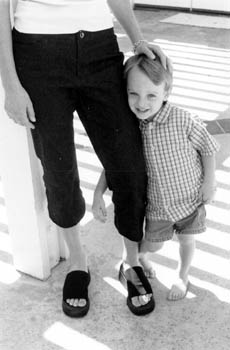|
Children can have hyperacusis. They often are unable to describe it very well using words, and instead use body or emotional gestures (crying, screaming, hitting, biting) to communicate. They may also simply try to 'get away'.
Research shows that about 17-20% of all children with autism or Asperger's or similar conditions will also have hyperacusis. Common signs include crying in noisy environments, clasping hands over the ears, fear of noise or noisy objects, self-harm when exposed to loud noise, i.e. vacuum cleaners, and reluctance to participate in noisy or loud activities, i.e. watch parades, birthday parties, musical presentations, etc. Children free of these conditions also can aquire hyperacusis, particularly following frequent or severe ear infections, head injuries, viruses, or medication adverse reactions, or unknown causes.
A Current Reseach Article
Prog Brain Res. 2007;166:169-78.
Hyperacusis, sound annoyance, and loudness hypersensitivity in children.
The objective of the present study was to estimate the prevalence of hyperacusis among school-aged children. We define hyperacusis as lowered loudness discomfort levels (LDL) associated with an abnormal annoyance to sounds. We used questionnaires, interviews, and estimates of LDL in a study of 506 children from 5 to 12 years of age from 15 different schools. Participants with LDL in the lowest 5th percentile were classified as having loudness hypersensitivity; an abnormal annoyance to sounds if they responded "yes" to the question "Are you bothered by any kind of sounds or noise?" could describe the sound, and were able to identify at least 10 sounds from a list of 20 as being annoying. Phonophobia was defined as a fear of sound. Children with LDL in the lowest 5th percentile typically had LDLs lower than 90 dB HL; 42% of the participants in this group were bothered by sounds and 3.2% had hyperacusis. Fifty percent of the participants with hyperacusis had tinnitus and mild hearing loss in the left ear was an associated risk factor. Phonophobia was experienced by 9% of the children. It is concluded that hyperacusis in children is prevalent, and should be considered in clinical examinations.
Many times, it is the subjective observations from parents, teachers, or care givers that is used to support a diagnosis of hyperacusis. Frequently, primary care physicians find it difficult to diagnose hyperacusis as a primary symtpom and will refer to an ear specialist.
Since 1997, our clinic has been fitting children with bilateral broadband signal generators, open ear canal styles, in patients as young as four years old. Our data, collected over 10 years, shows that about 2/3s of the children who try out these devices, benefit signficantly.
For some children, the sound acts like a masking therapy, removing some of the difficulties with sudden sounds or persistent intruding and irritating noises. The devices can be soothing and comforting for some children, raising the ambient noise levels which can create a calmer auditory environment.
All children who are eligible for the use of these devices should be examined thoroughly by a medical specialist (ENT or otolaryngologist) and audiologist first. In our clinic we also require these medical records as well as a detailed case history prior to determining if the therapy is a good 'fit'. A recent (within 1 year) record of an audiologic evaluation must be forwarded to the clinic prior to accepting any child for treatment.
All children in our clinic (18 and younger) receive a free 30 day trial period and all clinic fees are waived. The price for these bilateral devices has a range from $1200 to $2400, for two units, depending on the style and manufacturer. They are battery operated and have a volume control for adjusting the level of the sound. Children find them comfortable for the most part, and they are quite durable (thank goodness). All units are covered by loss and damage insurance for one year.
The clinic monitors progress and assists with configuring therapy for a period of six to twelve months if the family decides to keep the instruments. A fifty percent deposit is asked prior to the fitting of the devices, and the funds are returned (less a small charge for credit card processing) if the devices are returned. If the family wishes to keep the units, the other fifty percent is due on the 30th day, post fitting.
All devices fit on adults 19 and older, are non refundable. There may be exceptions to this rule, please make arrangements in advance. Your insurance company may be billed for the consultations or evaluations, as agreed in advance. Please note these are not 'hearing aids' and fall under the Durable Medical Goods codes.
To obtain an Application for Sound Therapy for Children, please email us at [email protected] or [email protected].

|